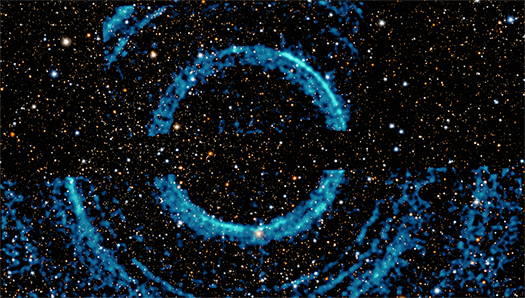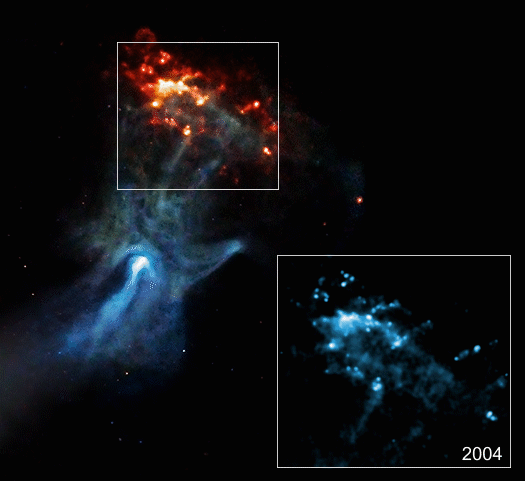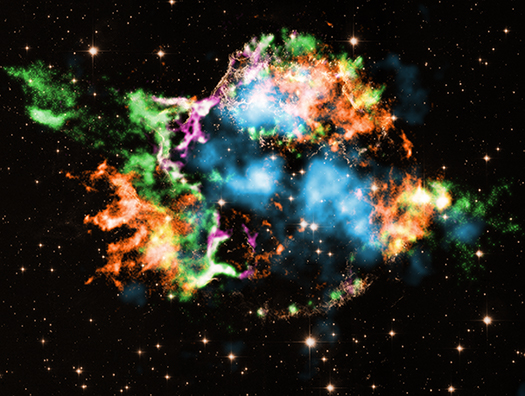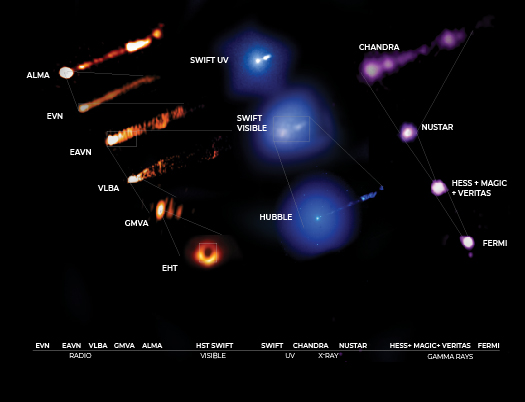"X-ray Magnifying Glass" Enhances View of Distant Black Holes
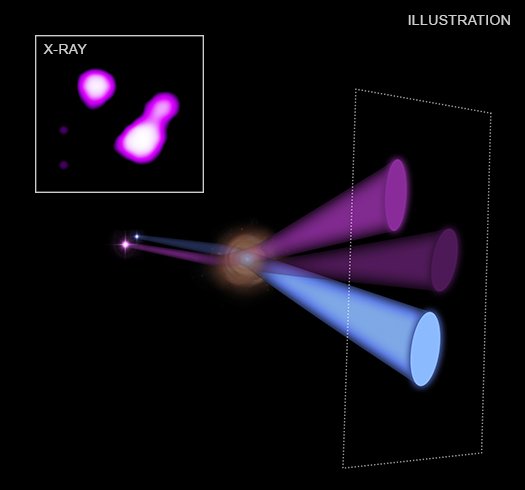
Gravitationally-Lensed System MG B2016+112
Credit: Illustration: NASA/CXC/M. Weiss; X-ray (inset): NASA/CXC/SAO/D. Schwartz et al.
A new technique using NASA's Chandra X-ray Observatory has allowed astronomers to obtain an unprecedented look at a black hole system in the early Universe, as reported in our latest press release. This is providing a way for astronomers to look at faint and distant X-ray objects in more detail than had previously been possible.
Astronomers used an alignment in space that shows "gravitational lensing" of light from two objects that are nearly 12 billion light years away. An artist's illustration in the main part of this graphic shows how the paths of light from these distant objects are bent and amplified by a galaxy along the line of sight between Earth and the objects.
Huge Rings Around a Black Hole
This image features a spectacular set of rings around a black hole, captured using NASA's Chandra X-ray Observatory and Neil Gehrels Swift Observatory. The X-ray images of the giant rings reveal information about dust located in our galaxy, using a similar principle to the X-rays performed in doctor's offices and airports.
The black hole is part of a binary system called V404 Cygni, located about 7,800 light years away from Earth. The black hole is actively pulling material away from a companion star — with about half the mass of the Sun — into a disk around the invisible object. This material glows in X-rays, so astronomers refer to these systems as "X-ray binaries."
Chandra Catches Slingshot During Collision
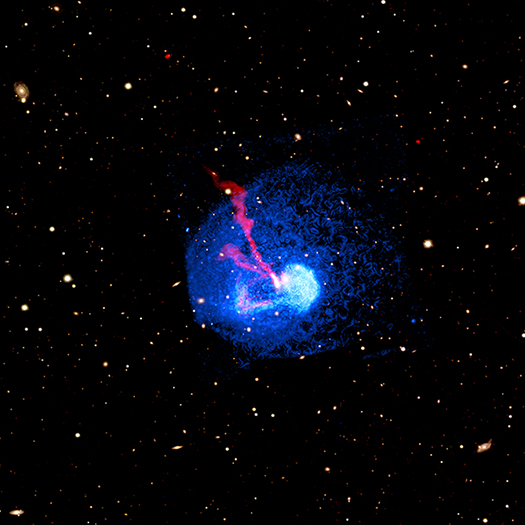
Abell 1775
Credit: X-ray: NASA/CXC/Leiden Univ./A. Botteon et al.; Radio: LOFAR/ASTRON; Optical/IR:PanSTARRS
When the titans of space — galaxy clusters — collide, extraordinary things can happen. A new study using NASA's Chandra X-ray Observatory examines the repercussions after two galaxy clusters clashed.
Galaxy clusters are the largest structures in the Universe held together by gravity, containing hundreds or even thousands of individual galaxies immersed in giant oceans of superheated gas. In galaxy clusters, the normal matter — like the atoms that make up the stars, planets, and everything on Earth — is primarily in the form of hot gas and stars. The mass of the hot gas between the galaxies is far greater than the mass of the stars in all of the galaxies. This normal matter is bound in the cluster by the gravity of an even greater mass of dark matter.
Because of the huge masses and speeds involved, collisions and mergers between galaxy clusters are among the most energetic events in the universe.
In a new study of the galaxy cluster Abell 1775, located about 960 million light years from Earth, a team of astronomers led by Andrea Botteon from Leiden University in the Netherlands announced that they found a spiral-shaped pattern in Chandra's X-ray data. These results imply a turbulent past for the cluster.
Galaxy Cluster Travels Down an Intergalactic Highway
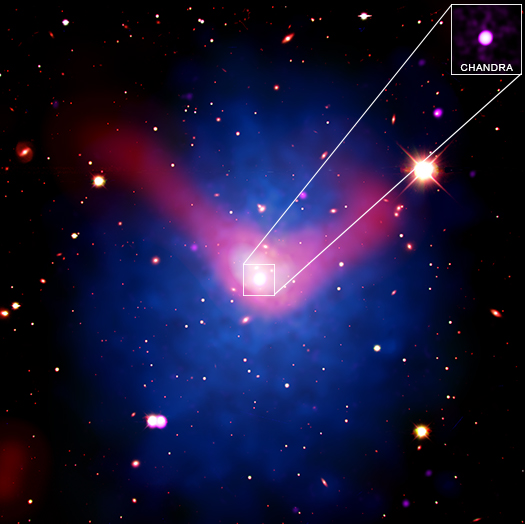
The Northern Clump
Credit: X-ray: (Chandra: NASA/CXC/Univ. Bonn/A. Veronica et al; XMM-Newton: ESA/XMM-Newton); Optical: DES/DOE/FNAL/DECam/CTIO/NOIRLab/NSF/AURA; Radio: CSIRO/ASKAP/EMU
Researchers have found a galaxy cluster acting like a passenger on what astronomers are calling an "intergalactic highway." The cluster is known as the "Northern Clump" and it is located about 690 million light years from Earth. Previously, scientists discovered an enormous filament, a thin strip of very hot gas that stretched for at least 50 million light years. A new study found evidence that the Northern Clump is traveling along this filament, similar to how a car moves along the interstate.
Cosmic Hand Hitting a Wall
Motions of a remarkable cosmic structure have been measured for the first time, using NASA's Chandra X-ray Observatory. The blast wave and debris from an exploded star are seen moving away from the explosion site and colliding with a wall of surrounding gas.
Astronomers estimate that light from the supernova explosion reached Earth about 1,700 years ago, or when the Mayan empire was flourishing and the Jin dynasty ruled China. However, by cosmic standards the supernova remnant formed by the explosion, called MSH 15-52, is one of the youngest in the Milky Way galaxy. The explosion also created an ultra-dense, magnetized star called a pulsar, which then blew a bubble of energetic particles, an X-ray-emitting nebula.
X-ray Screams From Toddler Suns

Konstantin Getman
We are very happy to welcome Dr. Konstantin Getman as our guest blogger, who is also the first author of the studies featured in our latest press release. He received an honor master's degree in astronomy at Moscow State University in 1994 and his Ph.D. degree in physics and mathematics at Pushkov Institute of Terrestrial Magnetism, Ionosphere and Radiowave Propagation of the Russian Academy of Sciences (IZMIRAN) in 1999. Since 2001, he has been at the Pennsylvania State University where he is currently a research professor. His research is focused on star formation and stellar activity, about which he authored and co-authored 80 peer-reviewed publications.
The Sun is covered with magnetic field lines like an animal is covered with fur. These twisted and sheared lines store a lot of “free” energy. When solar magnetic lines of opposite polarity come close to each other, they interact, change their topology, and release free energy, causing powerful and eruptive events, that scientists call “flares”. These flare processes include acceleration of charged particles in the Sun’s upper atmosphere (called the corona), emission of large amounts of radiation in various energy bands (such as radio, microwave, optical, and X-ray), and launching of streams of plasma and magnetic field into space (called coronal mass ejections, or CMEs).
Magnetized Threads Weave Spectacular Galactic Tapestry
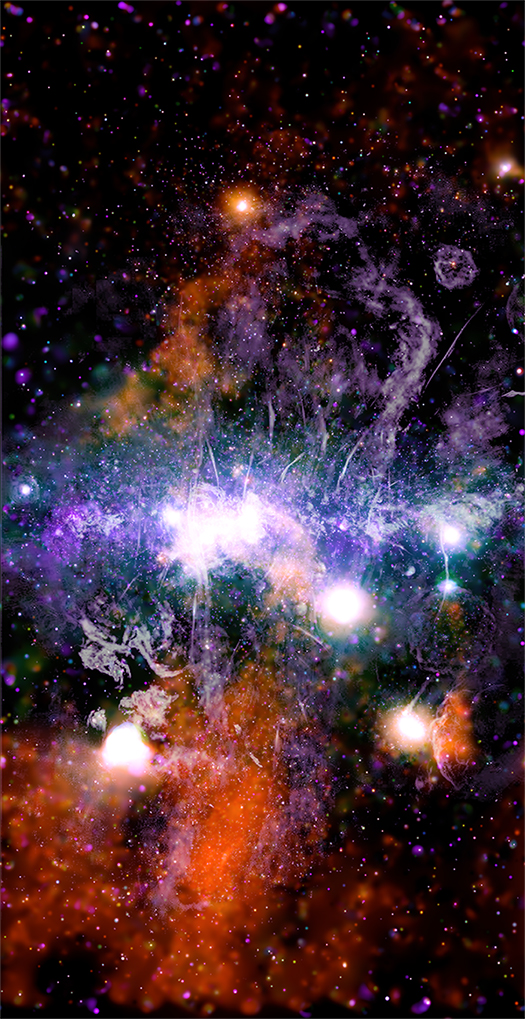
The Galactic Center of the Milky Way
Credit: X-ray: NASA/CXC/UMass/Q.D. Wang; Radio: NRF/SARAO/MeerKAT
Threads of superheated gas and magnetic fields are weaving a tapestry of energy at the center of the Milky Way galaxy. A new image of this new cosmic masterpiece was made using a giant mosaic of data from NASA's Chandra X-ray Observatory and the MeerKAT radio telescope in South Africa.
The new panorama of the Galactic Center builds on previous surveys from Chandra and other telescopes. This latest version expands Chandra's high-energy view farther above and below the plane of the Galaxy — that is, the disk where most of the Galaxy's stars reside — than previous imaging campaigns. In the image featured in our main graphic, X-rays from Chandra are orange, green, blue and purple, showing different X-ray energies, and the radio data from MeerKAT are shown in lilac and gray. The main features in the image are shown in a labeled version.
Chandra Discoveries in 3D Available on New Platform
Your browser does not support the video tag.
![]() More Information
More Information
Credit: VR version: VR model: NASA/CXC/Brown Univ./A.Dupuis et al.;
Simulation: INAF/S. Ustamujic et al.; X-ray data: NASA/CXC/MSFC/D.Swartz et al.
A collection of the 3D objects from NASA's Chandra X-ray Observatory is now available on a new platform from the Smithsonian Institution. This will allow greater access to these unique 3D models and prints for institutions like libraries and museums as well as the scientific community and individuals in the public.
The Chandra X-ray Observatory is one of NASA's Great Observatories (along with the Hubble Space Telescope, Spitzer Space Telescope, and Compton Gamma-ray Observatory). Chandra, the world's most powerful X-ray telescope, is operated by the Smithsonian Astrophysical Observatory in Massachusetts.
Chandra's 3D datasets are now included in Voyager, a platform developed by the Smithsonian's Digitization Program Office, which enables datasets to be used as tools for learning and discovery. Viewers can explore these fascinating 3D representations of objects in space alongside a statue of George Washington or a skeleton of an extinct mammoth.
Bubbles With Titanium Trigger Titanic Explosions
Astronomers using NASA's Chandra X-ray Observatory have announced the discovery of an important type of titanium, along with other elements, blasting out from the center of the supernova remnant Cassiopeia A (Cas A). This new result, as outlined in our latest press release, could be a major step for understanding exactly how some of the most massive stars explode.
The different colors in this new image mostly represent elements detected by Chandra in Cas A: iron (orange), oxygen (purple), and the amount of silicon compared to magnesium (green). Titanium (light blue) detected previously by NASA's NuSTAR telescope at higher X-ray energies is also shown. These Chandra and NuSTAR X-ray data have been overlaid on an optical-light image from the Hubble Space Telescope (yellow).
Telescopes Unite in Unprecedented Observations of Famous Black Hole
Your browser does not support the video tag.
![]() More Information
More Information
Video compilation: NASA/GSFC/SVS/M.Subbarao & NASA/CXC/SAO/A.Jubett
In April 2019, scientists released the first image of a black hole in the galaxy M87 using the Event Horizon Telescope (EHT). This supermassive black hole weighs 6.5 billion times the mass of the sun and is located at the center of M87, about 55 million light-years from Earth.
The supermassive black hole is powering jets of particles that travel at almost the speed of light, as described in our latest press release. These jets produce light spanning the entire electromagnetic spectrum, from radio waves to visible light to gamma rays.
To gain crucial insight into the black hole's properties and help interpret the EHT image, scientists coordinated observations with 19 of the world's most powerful telescopes on the ground and in space, collecting light from across the spectrum. This is the largest simultaneous observing campaign ever undertaken on a supermassive black hole with jets.
The NASA telescopes involved in this observing campaign included the Chandra X-ray Observatory, Hubble Space Telescope, Neil Gehrels Swift Observatory, the Nuclear Spectroscopic Telescope Array (NuSTAR), and the Fermi Gamma-ray Space Telescope.

